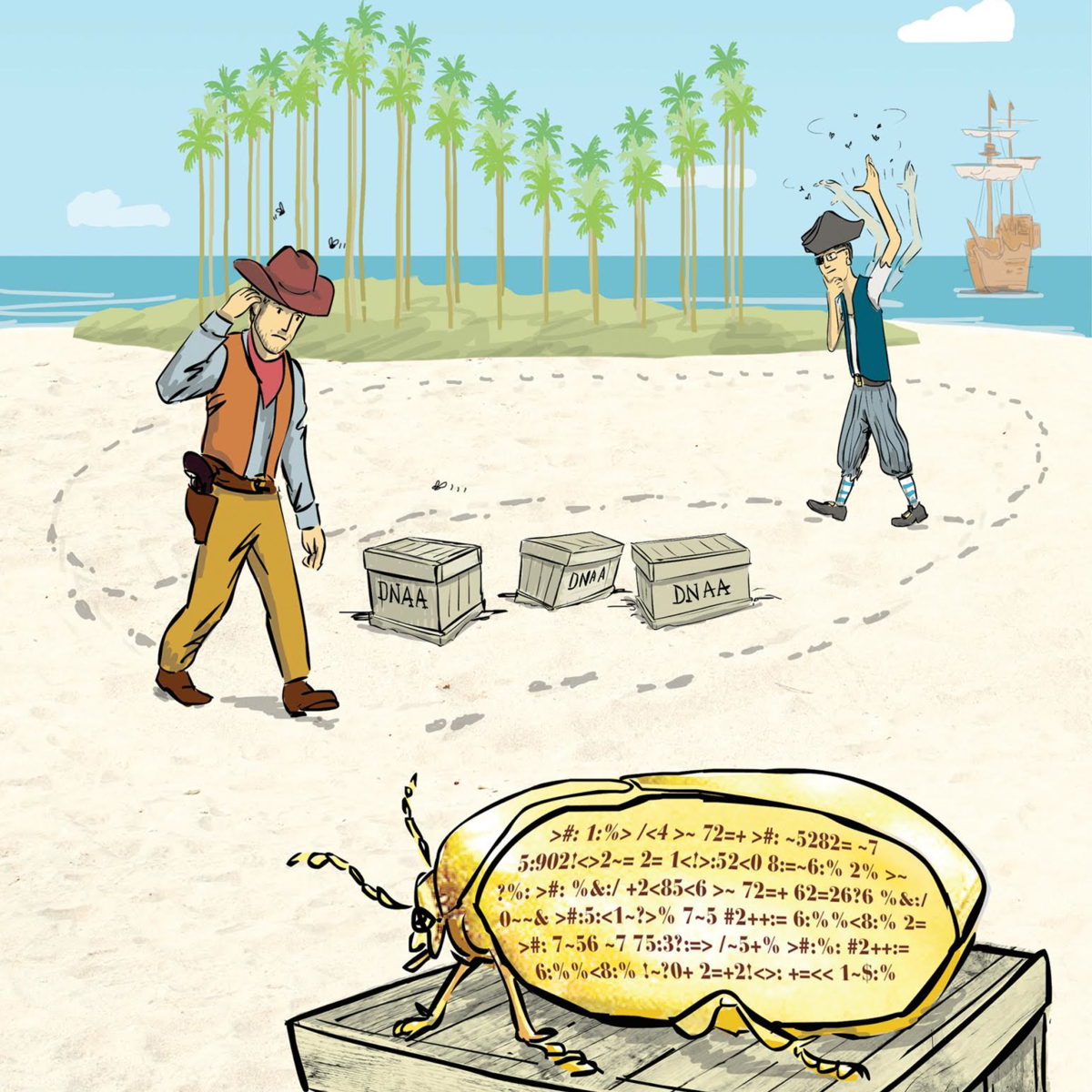
Are you interested in learning how to program (in Python) within a scientific setting?
This course will cover algorithms for solving various biological problems along with a handful of programming challenges helping you implement these algorithms in Python. It offers a gently-paced introduction to our Bioinformatics Specialization (https://www.coursera.org/specializations/bioinformatics), preparing learners to take the first course in the Specialization, "Finding Hidden Messages in DNA" (https://www.coursera.org/learn/dna-analysis).
Read more
Are you interested in learning how to program (in Python) within a scientific setting?
This course will cover algorithms for solving various biological problems along with a handful of programming challenges helping you implement these algorithms in Python. It offers a gently-paced introduction to our Bioinformatics Specialization (https://www.coursera.org/specializations/bioinformatics), preparing learners to take the first course in the Specialization, "Finding Hidden Messages in DNA" (https://www.coursera.org/learn/dna-analysis).
Are you interested in learning how to program (in Python) within a scientific setting?
This course will cover algorithms for solving various biological problems along with a handful of programming challenges helping you implement these algorithms in Python. It offers a gently-paced introduction to our Bioinformatics Specialization (https://www.coursera.org/specializations/bioinformatics), preparing learners to take the first course in the Specialization, "Finding Hidden Messages in DNA" (https://www.coursera.org/learn/dna-analysis).
Each of the four weeks in the course will consist of two required components. First, an interactive textbook provides Python programming challenges that arise from real biological problems. If you haven't programmed in Python before, not to worry! We provide "Just-in-Time" exercises from the Codecademy Python track (https://www.codecademy.com/learn/python). And each page in our interactive textbook has its own discussion forum, where you can interact with other learners. Second, each week will culminate in a summary quiz.
Lecture videos are also provided that accompany the material, but these videos are optional.
What's inside
Syllabus
Week 1
Where in the Genome Does Replication Begin? (Part 1)
Week 2
Where in the Genome Does Replication Begin? (Part 2)
Read more
Syllabus
Good to know
Save this course
Reviews summary
Discovery with data: bioinformatics for life scientists
Activities
Review 'Bioinformatics and Functional Genomics' by Jonatha M. Keith
Show steps
Review 'Bioinformatics and Functional Genomics' for a theoretical background on concepts that will be covered in the course.
Show steps
-
Read the first two chapters and complete any associated questions.
-
Complete the practice exercises at the end of each chapter.
-
Join the discussion forum for the book and participate in discussions.
Solve Python Programming Challenges on Codecademy
Show steps
Practice solving Python programming challenges to improve your coding skills and prepare for the course assignments.
Browse courses on
Python
Show steps
-
Complete the Python track on Codecademy.
-
Solve at least 10 challenges in each section of the track.
-
Join the discussion forum for the track and ask questions or help others.
Follow Tutorials on Bioinformatics Tools and Techniques
Show steps
Follow tutorials to learn about bioinformatics tools and techniques that will be used in the course.
Browse courses on
Bioinformatics
Show steps
-
Find tutorials on topics such as sequence alignment, gene prediction, and phylogenetic analysis.
-
Follow the tutorials and complete any associated exercises.
-
Join the discussion forums for the tutorials and ask questions or share insights.
Five other activities
Expand to see all activities and additional details
Show all eight activities
Write a Blog Post Summarizing a Course Lecture
Show steps
Write a blog post summarizing a course lecture to reinforce your understanding of the material and share it with others.
Browse courses on
Bioinformatics
Show steps
-
Choose a lecture topic that you found particularly interesting or challenging.
-
Write a blog post that summarizes the key points of the lecture, provides examples, and discusses your own insights.
-
Share your blog post with your classmates and instructor for feedback.
Attend Study Sessions with Classmates
Show steps
Attend study sessions with classmates to review course material, work on assignments, and ask questions.
Browse courses on
Bioinformatics
Show steps
-
Organize a study session with classmates.
-
Review the course material together, focusing on difficult concepts.
-
Work on assignments together and help each other understand the solutions.
Mentor a Junior Student
Show steps
Mentor a junior student who is taking a lower-level bioinformatics course to reinforce your understanding and help others succeed.
Browse courses on
Bioinformatics
Show steps
-
Offer to mentor a junior student through your university's mentoring program.
-
Meet with the student regularly to review course material, provide guidance, and answer questions.
-
Share your own experiences and insights to help the student succeed.
Attend Bioinformatics Conferences and Meetups
Show steps
Attend bioinformatics conferences and meetups to connect with professionals in the field, learn about the latest research, and expand your knowledge.
Browse courses on
Bioinformatics
Show steps
-
Find bioinformatics conferences and meetups in your area.
-
Attend the events and introduce yourself to speakers and attendees.
-
Ask questions, share your insights, and learn from others.
Contribute to an Open-Source Bioinformatics Project
Show steps
Contribute to an open-source bioinformatics project to gain practical experience, build your portfolio, and give back to the community.
Browse courses on
Bioinformatics
Show steps
-
Find an open-source bioinformatics project that you are interested in.
-
Read the project documentation and familiarize yourself with the codebase.
-
Identify a bug or feature that you can contribute to.
Review 'Bioinformatics and Functional Genomics' by Jonatha M. Keith
Show steps
Review 'Bioinformatics and Functional Genomics' for a theoretical background on concepts that will be covered in the course.
Show steps
- Read the first two chapters and complete any associated questions.
- Complete the practice exercises at the end of each chapter.
- Join the discussion forum for the book and participate in discussions.
Solve Python Programming Challenges on Codecademy
Show steps
Practice solving Python programming challenges to improve your coding skills and prepare for the course assignments.
Browse courses on
Python
Show steps
- Complete the Python track on Codecademy.
- Solve at least 10 challenges in each section of the track.
- Join the discussion forum for the track and ask questions or help others.
Follow Tutorials on Bioinformatics Tools and Techniques
Show steps
Follow tutorials to learn about bioinformatics tools and techniques that will be used in the course.
Browse courses on
Bioinformatics
Show steps
- Find tutorials on topics such as sequence alignment, gene prediction, and phylogenetic analysis.
- Follow the tutorials and complete any associated exercises.
- Join the discussion forums for the tutorials and ask questions or share insights.
Write a Blog Post Summarizing a Course Lecture
Show steps
Write a blog post summarizing a course lecture to reinforce your understanding of the material and share it with others.
Browse courses on
Bioinformatics
Show steps
- Choose a lecture topic that you found particularly interesting or challenging.
- Write a blog post that summarizes the key points of the lecture, provides examples, and discusses your own insights.
- Share your blog post with your classmates and instructor for feedback.
Attend Study Sessions with Classmates
Show steps
Attend study sessions with classmates to review course material, work on assignments, and ask questions.
Browse courses on
Bioinformatics
Show steps
- Organize a study session with classmates.
- Review the course material together, focusing on difficult concepts.
- Work on assignments together and help each other understand the solutions.
Mentor a Junior Student
Show steps
Mentor a junior student who is taking a lower-level bioinformatics course to reinforce your understanding and help others succeed.
Browse courses on
Bioinformatics
Show steps
- Offer to mentor a junior student through your university's mentoring program.
- Meet with the student regularly to review course material, provide guidance, and answer questions.
- Share your own experiences and insights to help the student succeed.
Attend Bioinformatics Conferences and Meetups
Show steps
Attend bioinformatics conferences and meetups to connect with professionals in the field, learn about the latest research, and expand your knowledge.
Browse courses on
Bioinformatics
Show steps
- Find bioinformatics conferences and meetups in your area.
- Attend the events and introduce yourself to speakers and attendees.
- Ask questions, share your insights, and learn from others.
Contribute to an Open-Source Bioinformatics Project
Show steps
Contribute to an open-source bioinformatics project to gain practical experience, build your portfolio, and give back to the community.
Browse courses on
Bioinformatics
Show steps
- Find an open-source bioinformatics project that you are interested in.
- Read the project documentation and familiarize yourself with the codebase.
- Identify a bug or feature that you can contribute to.
Career center
Bioinformatician
Computational Biologist
Data Scientist
Software Engineer
Database Administrator
Systems Analyst
Web Developer
Technical Writer
Science Writer
Statistician
Epidemiologist
Biomedical Engineer
Healthcare Informatics Specialist
Medical Laboratory Scientist
Research Scientist
Reading list
Share
Similar courses
OpenCourser helps millions of learners each year. People visit us to learn workspace skills, ace their exams, and nurture their curiosity.
Our extensive catalog contains over 50,000 courses and twice as many books. Browse by search, by topic, or even by career interests. We'll match you to the right resources quickly.
Find this site helpful? Tell a friend about us.
We're supported by our community of learners. When you purchase or subscribe to courses and programs or purchase books, we may earn a commission from our partners.
Your purchases help us maintain our catalog and keep our servers humming without ads.
Thank you for supporting OpenCourser.



